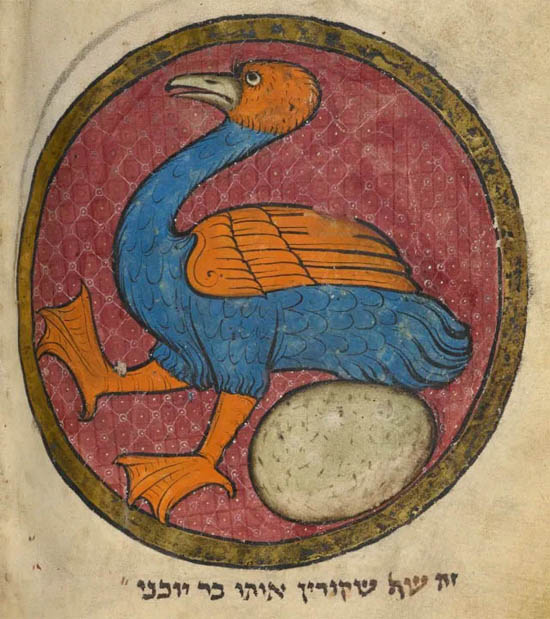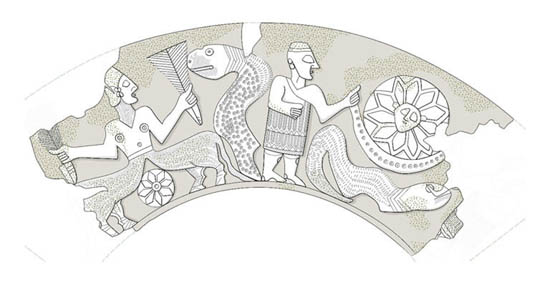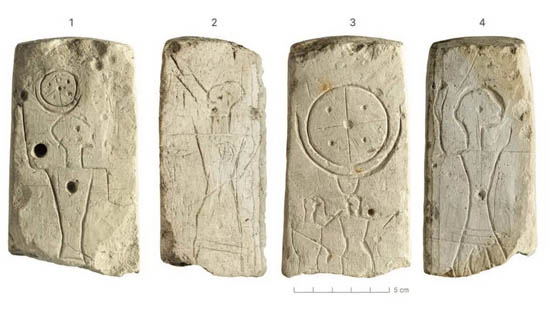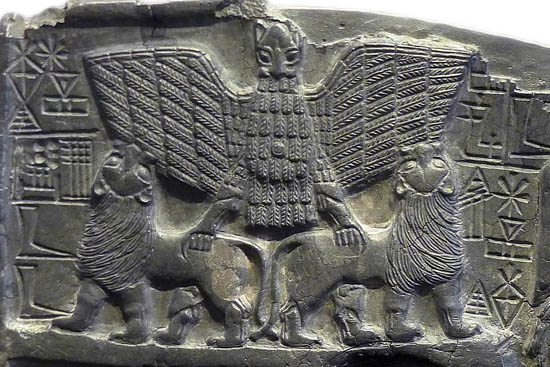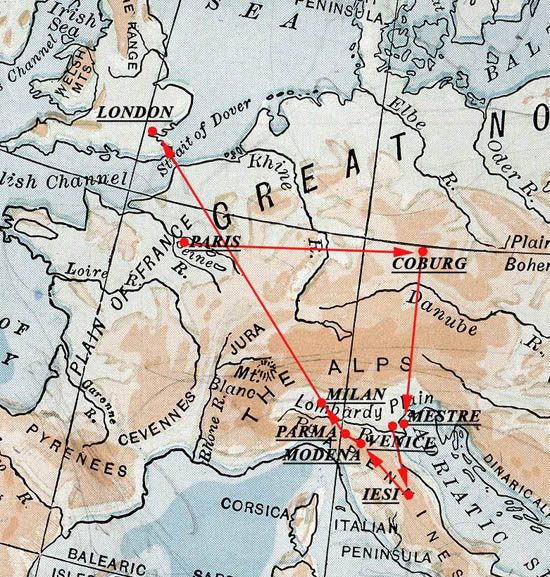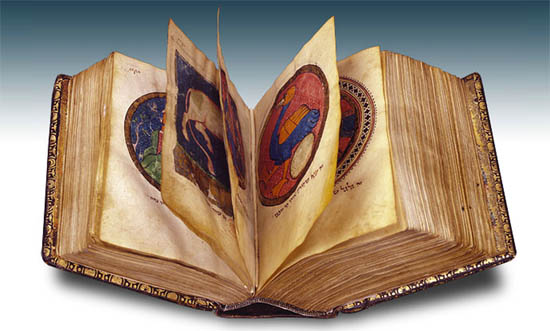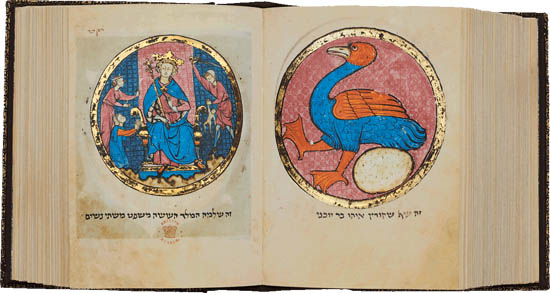Pronto nos despediremos de Blogger
y pasaremos a una nueva plataforma, donde
• en aún más idiomas
• con un material visual mucho más rico
• de forma más clara, mejor estructurada y más fácil de buscar
• y equipada con muchas herramientas nuevas
• publicaremos con más frecuencia y con contenidos aún mejores :)
Nuestra nueva página:
https://riowang.studiolum.com/es/
o en versión corta: https://riowang.com
Hasta que finalice el desarrollo completo de la nueva página
—aproximadamente a finales de año—
publicaremos nuestras entradas en ambas plataformas en paralelo,
pero a partir de Año Nuevo solo en la nueva.
Hasta entonces, vale la pena ir acostumbrándose, suscribirse al RSS,
probar con nosotros las nuevas funciones
y enviarnos sugerencias sobre qué y cómo deberíamos mejorar.
¡Gracias!
Introdujimos un epílogo judío a nuestra publicación sobre san Martín y sus gansos con esta miniatura que muestra un ave más o menos como un ganso (coloreado, eso sí) y una línea inequívocamente judía al pie, cosa que la legitimaba para ilustrar aquella curiosa historia de los judíos que transportaban gansos asados a Viena el día de san Martín.
Pero, ¿qué pájaro es realmente este, con ese enorme huevo?
La inscripción dice: זה עוף שקורין אותו בר יוכני zeh ʿof she-qorin oto Bar Yochnei, es decir, «Esta es el ave llamada Bar Yochnei.»
De acuerdo. Ahora solo falta averiguar qué pájaro es el Bar Yochnei.
1.
El nombre aparece en el Talmud babilónico. El tratado Bekhorot 57b, entre historias entretenidas de animales y plantas extraordinarios, nos dice:
«Una vez, el ave llamada bar yokhani (=el hijo del nido) dejó caer un huevo, y el contenido del huevo inundó sesenta ciudades y arrancó trescientos cedros.»
La misma ave gigantesca también aparece en el Bava Batra 73b, entre las historias de Rabbah bar bar Hana, cuyas aventuras y experiencias maravillosas se integraron incluso en las peripecias de Simbad:
«Una vez, viajando en barco, vimos un ave que estaba en el agua hasta los tobillos [kartzuleih] y su cabeza alcanzaba el cielo. Dijimos: aquí el agua no es profunda, y quisimos bajar para refrescarnos. Pero una voz divina nos dijo: 'No bajen aquí, porque el hacha de un carpintero cayó hace siete años y todavía no ha llegado al fondo'. […] Rav Ashi dijo: Este ave se llama ziz sadai, como está escrito: ‘Conozco todas las aves de los montes; y el ziz sadai es mío’ (Salmos 50:11).”
La existencia de un ave tan colosal ya es un milagro, pero que existan dos sería milagro aún mayor. Por eso, comentaristas posteriores del Talmud—tácitamente el Yalkut Shimoni medieval y, de forma explícita, por primera vez el Maharsha de Polonia (1555-1631) en su comentario sobre Bekhorot 57b—identifican a ambos como una misma criatura.
2.
Así que ahora sabemos que el Bar Yochnei es lo mismo que el ziz sadai. Pero, ¿qué demonios es un ziz sadai?
Aquí ya estamos un poco mejor, porque el ziz sadai se menciona en dos salmos. Sin embargo, la palabra no aparece en ningún otro lugar de la Escritura; solo el contexto del Salmo 50:10-11 nos da pistas:
כִּי־לִ֥י כָל־חַיְתֹו־יָ֑עַר בְּ֝הֵמֹ֗ות בְּהַרְרֵי־אָֽלֶף׃
יָ֭דַעְתִּי כָּל־ע֣וֹף הָרִ֑ים וְזִ֥יז שָׂ֝דַ֗י עִמָּדִֽי׃
Ki-lī kol-ḥaytō-yā‘ar, behēmōt beharᵉrê-’ālef.
Yāda‘tī kol-‘ōf hārīm, ve zīz sāday ‘immādī.
El problema es que estas líneas se han traducido de varias maneras, dependiendo de cómo se interpreten los términos behēmōt y zīz sāday:
for every animal of the forest is mine, and the cattle on a thousand hills.
I know every bird in the mountains, and the insects in the fields are mine.
(New International Version)
Míos son todos los animales del bosque, ¡los miles de animales que hay en las colinas!
Mías son todas las aves de los montes; mío es todo lo que se mueve en los campos.
(Reina-Valera Contemporánea)
Mas La traducción literal, dejando lo que no tiene una interpretación clara, sería:
Porque mío es todo animal del bosque, el behemot en mil montes.
Conozco todas las aves del cielo, y el ziz sadai es mío.
La interpretación de Ziz Sadai como «insecto del campo» o «lo que se mueve en los campos» proviene del influyente Rashi del siglo XI, quien derivó ziz del verbo zuz, «moverse rápidamente». Pero la mayoría de los primeros comentaristas del Talmud, que aún estaban dentro del contexto original, lo entendieron como un ave, y no cualquier ave, sino un ave gigantesca. Ellos comprendieron que estas dos líneas, cada una con un hapax legomenon, confirmaban que cada una designaba a una criatura mítica, y que Adonai se glorificaba al declararse señor de ambas. Al igual que hace con la tercera criatura, el Leviatán, que presenta como prueba de su grandeza en el Libro de Job (40:25-32), como ya vimos:
¿Podrás pescar al Leviatán con un anzuelo? ¿harás pacto con él para que sirva a tu voluntad una vez por todas?
Así, los tres animales —Behemot, Leviatán y ziz sadai— forman un conjunto inseparable. Tres criaturas colosales que superan con creces cualquier dimensión humana, pero que aún así permanecen bajo el dominio de Adonai. Según los comentaristas del Talmud, Behemot es la criatura milagrosa de la tierra, Leviatán la del mar, y el ziz sadai la del aire, siendo este un ave gigantesca.
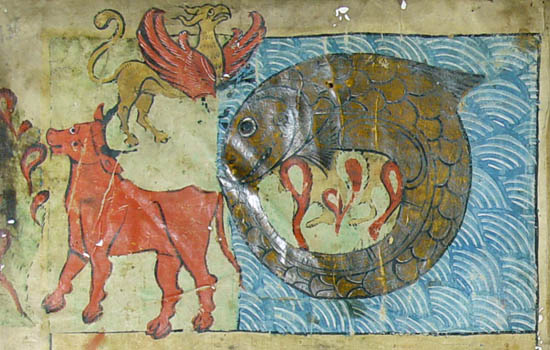 Behemot, Leviatán y el ziz sadai aparecen en la Biblia hebrea de Ulm de la Bibliotheca Ambrosiana, datada entre 1236 y 1238.
Behemot, Leviatán y el ziz sadai aparecen en la Biblia hebrea de Ulm de la Bibliotheca Ambrosiana, datada entre 1236 y 1238.
Hablando del Leviatán, ya mencionamos que proviene de los antiguos relatos de la creación del Cercano Oriente, que los judíos exiliados en Babilonia conocían muy bien y tejieron en su propia mitología. Durante el periodo del Segundo Templo, los estrictos editores sacerdotales eliminaron estos mitos de la versión oficial de la Torá que compilaron, pero aún así quedaron suficientes huellas en libros poéticos o anecdóticos, como los Salmos o el Libro de Job.
La idea fundamental de estas narraciones de la creación es que el dios o los dioses —ya sea Elil o Marduk, que más tarde ocuparía su lugar— debían someter primero al caos y a sus príncipes rebeldes, principalmente en las aguas, pero también en la tierra y en el aire.
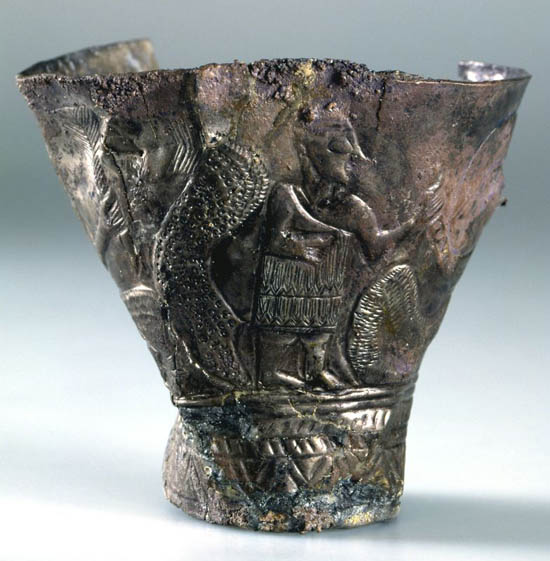 El llamado cáliz ʻAin Samiya, hallado cerca de Ramala (aprox. 2300-2000 a.C., hoy en el Museo de Israel en Jerusalén), representa la más antigua ilustración conocida de la historia de la creación. En él, la deidad, tras vencer al caos, pone el sol en un bote sobre las aguas celestiales. Más abajo, el llamado prisma de Lidar Höyük (alrededor de 1800 a.C.) muestra escenas similares de la salida del sol, lo que indica que este mito era ampliamente conocido en el Antiguo Oriente. Todo esto se documenta en el último número del Smithsonian Magazine, del 13 de noviembre de 2025.
El llamado cáliz ʻAin Samiya, hallado cerca de Ramala (aprox. 2300-2000 a.C., hoy en el Museo de Israel en Jerusalén), representa la más antigua ilustración conocida de la historia de la creación. En él, la deidad, tras vencer al caos, pone el sol en un bote sobre las aguas celestiales. Más abajo, el llamado prisma de Lidar Höyük (alrededor de 1800 a.C.) muestra escenas similares de la salida del sol, lo que indica que este mito era ampliamente conocido en el Antiguo Oriente. Todo esto se documenta en el último número del Smithsonian Magazine, del 13 de noviembre de 2025.
En las aguas, Tiamat-Leviatán; en la tierra, el toro divino —con el que incluso Gilgamesh debe enfrentarse— y en el aire… ahí está Anzu (su nombre original sumerio/acadio: Imdugud), un enorme pájaro de cara de león que habita en las montañas. Según el mito acadio más antiguo que se conserva, Anzu roba las tablas del destino de Enlil —que otorgan a su dueño poder sobre el destino de todos los seres vivos— y es el hijo de Enlil, Ninurta, quien debe derrotarlo y recuperarlas. Con Anzu, también el mundo del caos se rebela contra el nuevo orden, y son los dioses quienes deben someterlo.
Todo esto está detalladamente documentado por Nini Wazana, de la Hebrew University of Jerusalem, en su artículo “Anzu and Ziz: Great Mythical Birds in Ancient Near Eastern, Biblical, and Rabbinic Traditions”, publicado en el Journal of the Ancient Near Eastern Society 31 (2009).
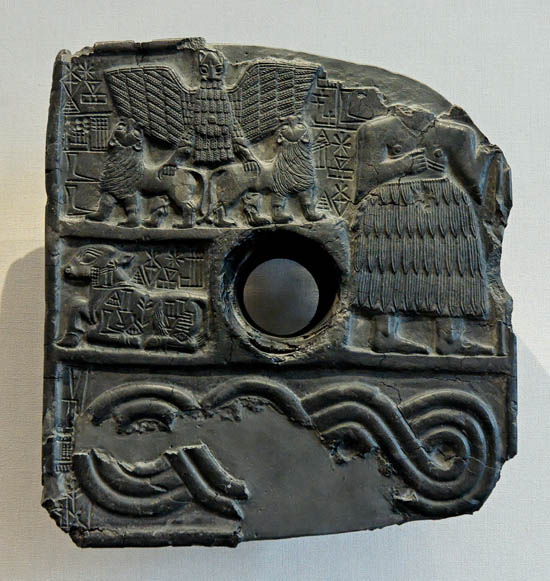 Anzu/Imdugud aparece en la tabla votiva del rey lagashita Entemena, ca. 2400 a.C., Louvre
Anzu/Imdugud aparece en la tabla votiva del rey lagashita Entemena, ca. 2400 a.C., Louvre
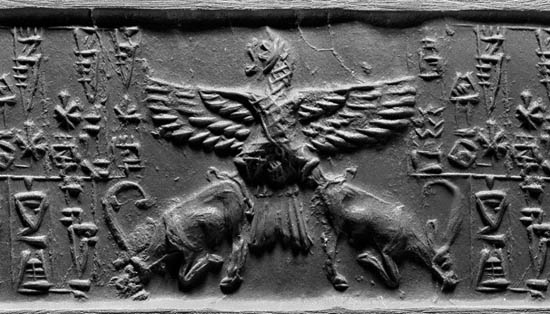 Anzu/Imdugud con dos íbices en un sello de ca. 2154–2100 a.C., Morgan Library & Museum
Anzu/Imdugud con dos íbices en un sello de ca. 2154–2100 a.C., Morgan Library & Museum
 Anzu/Imdugud con dos ciervos en un friso de cobre de ca. 2500 a.C. de Tell-el-Obed, del antiguo templo de Ninhursag, British Museum
Anzu/Imdugud con dos ciervos en un friso de cobre de ca. 2500 a.C. de Tell-el-Obed, del antiguo templo de Ninhursag, British Museum
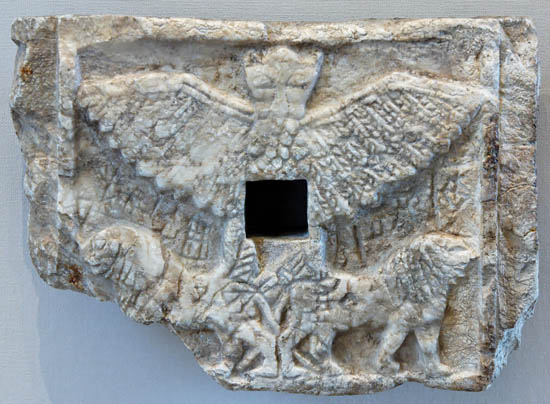 Anzu/Imdugud en un relieve votivo del rey Ur-Nanshe de Lagash, de la antigua ciudad de Girsu, ca. 2550–2500 a.C., Louvre
Anzu/Imdugud en un relieve votivo del rey Ur-Nanshe de Lagash, de la antigua ciudad de Girsu, ca. 2550–2500 a.C., Louvre
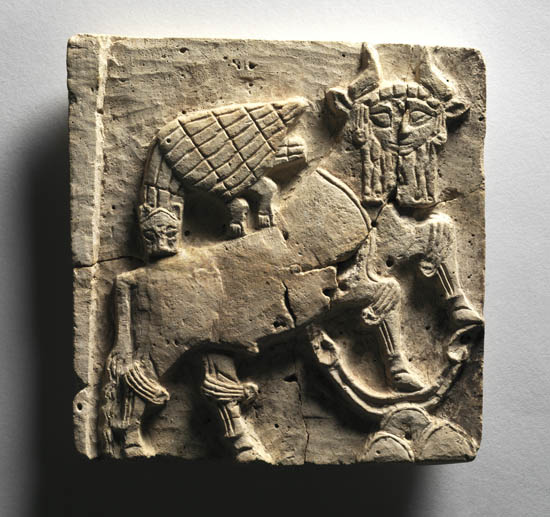 Anzu/Imdugud atacando un toro (quizá representación simbólica de la luna menguante), Tell-el-Obed, ca. 2600–2500 a.C., Penn Museum, Filadelfia
Anzu/Imdugud atacando un toro (quizá representación simbólica de la luna menguante), Tell-el-Obed, ca. 2600–2500 a.C., Penn Museum, Filadelfia
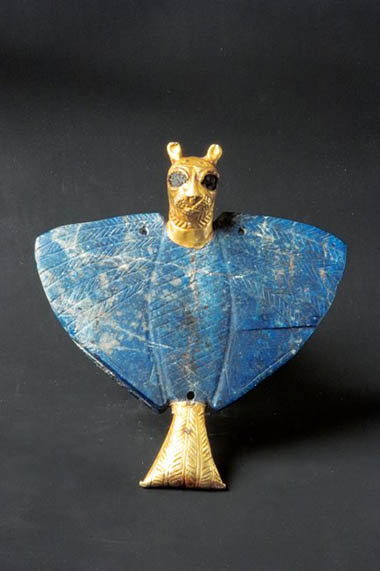 Anzu/Imdugud en un colgante de lapislázuli y oro del llamado «tesoro de Uri» descubierto en el palacio real de Mari (supuesto regalo del rey de Ur al rey de Mari), ca. 2500 a.C., Museo Nacional de Siria, Damasco
Anzu/Imdugud en un colgante de lapislázuli y oro del llamado «tesoro de Uri» descubierto en el palacio real de Mari (supuesto regalo del rey de Ur al rey de Mari), ca. 2500 a.C., Museo Nacional de Siria, Damasco
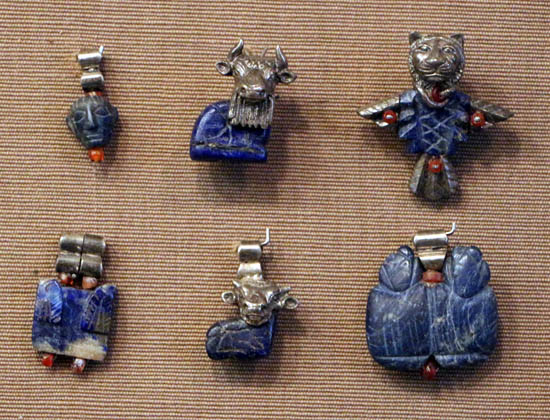 Anzu/Imdugud en el tesoro de Tell Asmar, de la antigua ciudad de Eshnunna, Bagdad, Iraq Museum
Anzu/Imdugud en el tesoro de Tell Asmar, de la antigua ciudad de Eshnunna, Bagdad, Iraq Museum
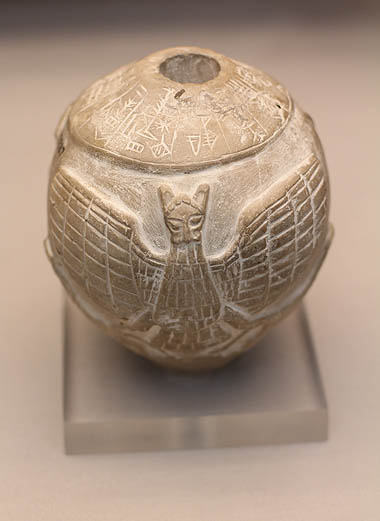 Anzu/Imdugud en el bastón votivo ofrecido por el rey Mesilim de Kish a la deidad Ningursu, de la antigua Girsu, ca. 2600–2500 a.C., British Museum
Anzu/Imdugud en el bastón votivo ofrecido por el rey Mesilim de Kish a la deidad Ningursu, de la antigua Girsu, ca. 2600–2500 a.C., British Museum
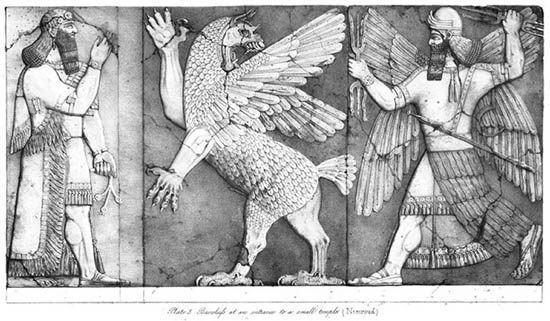 El combate entre Ninurta y Anzu en el relieve de la entrada del templo de la ciudad asiria de Nimrud, hoy en el British Museum. Grabado de Ludwig Gruner en Monuments of Nineveh, de Austen Henry Layard (1853). La descripción detallada del relieve puede leerse aquí
El combate entre Ninurta y Anzu en el relieve de la entrada del templo de la ciudad asiria de Nimrud, hoy en el British Museum. Grabado de Ludwig Gruner en Monuments of Nineveh, de Austen Henry Layard (1853). La descripción detallada del relieve puede leerse aquí
 Ninurta atacando a Anzu, sello neoasirio de Nimrud, siglo VIII–VII a.C., The Walters Art Museum
Ninurta atacando a Anzu, sello neoasirio de Nimrud, siglo VIII–VII a.C., The Walters Art Museum
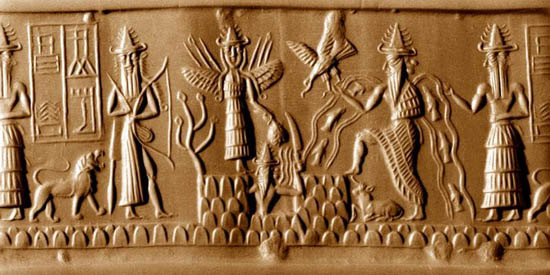 El llamado Sello de Adda, ca. 2300 a.C.: Anzu/Imdugud ante el tribunal de los dioses, British Museum
El llamado Sello de Adda, ca. 2300 a.C.: Anzu/Imdugud ante el tribunal de los dioses, British Museum
Que Anzu realmente haya sobrevivido en los salmos bajo el nombre de ziz sadai durante tres mil años lo demuestra que la palabra sāday —hapax legomenon, única en la Biblia y de significado incierto— proviene del epíteto acadio original de Anzu/Imdugud, šadû, que significa «montañés». Para Mesopotamia, las montañas eran lo desconocido y amenazante, de donde venían atacantes y tormentas, y Anzu era el dios de estos.
Otra pista la da la segunda aparición del nombre: el Salmo 80 describe a Israel como una vid magnífica sacada de Egipto y plantada en tierra nueva, ahora devastada por el enemigo:
יְכַרְסְמֶ֣נָּֽה חֲזִ֣יר מִיָּ֑עַר וְזִ֖יז שָׂדַ֣י יִרְעֶֽנָּה׃
Yekharsemennā ḥazīr miyyā‘ar, ve zīz sāday yir‘ennā
«Destruye el jabalí del bosque y devora el zīz sāday.»
Según Nini Wazana, estos dos seres corresponden simbólicamente a los dos enemigos que amenazaban a Israel en la época en que se compuso el salmo: el jabalí representa a Egipto, y el zīz sāday a la Asiria montañosa.
3.
La leyenda de nuestra «ilustración del ganso» no dice nada sobre toda esta historia de tres mil años. Ni tampoco el volumen en el que aparece.
La imagen proviene de un códice medieval conocido como North French Hebrew Miscellany, compilado entre 1277 y 1298 en el norte de Francia. Desde allí emprendió un viaje bastante aventurero: pasó por Alemania, Venecia, Padua y Milán, hasta llegar finalmente a la British Library en 1839 (Add MS 11639).
Este enorme manuscrito, formado por 746 folios de pergamino (1.492 páginas), contiene, además de la Torá, textos litúrgicos, la Hagadá, el texto hebreo más antiguo conocido del Libro de Tobit, escritos legales y poemas de Moisés ibn Ezra. Fue copiado por un único escriba, Benjamín, aunque sus 49 miniaturas fueron realizadas por varios artistas. Las imágenes estuvieron disponibles en la web de la British Library, pero desaparecieron con el tiempo. La editorial Facsimile Editions, especializada en facsímiles de manuscritos hebreos, publicó este códice, y todas las ilustraciones se pueden ver en su página web.
Las imágenes, que representan principalmente escenas bíblicas, no guardan mucha relación con el texto y forman, en cierto modo, una especie de miscelánea dentro de la miscelánea. Sus modelos provienen de la pintura gótica parisina de la época; el ave Bar Yochnei, por ejemplo, se inspira en los bestiarios cristianos contemporáneos.
La imagen del Bar Yochnei se enfrenta con el Juicio de Salomón. Entre ambas no se perciben muchas conexiones evidentes. Pero al pasar solo una página, nos encontramos con viejos conocidos. Aquí están: ¡Behemot y Leviatán!
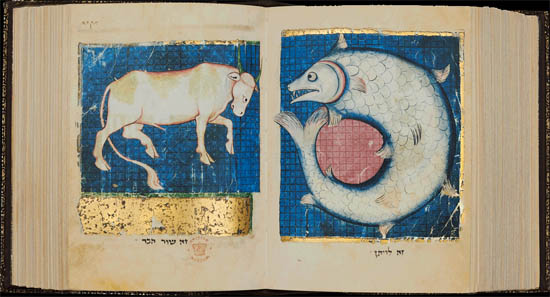 fol. 518b-519a. זה שור הבר ze shor ha-bar «este es el buey salvaje» = Behemot, y זה לויתן ze livyātan «este es el Leviatán»
fol. 518b-519a. זה שור הבר ze shor ha-bar «este es el buey salvaje» = Behemot, y זה לויתן ze livyātan «este es el Leviatán»
En el siglo V, Esdras y Nehemías, al regresar del exilio babilónico y preparar la versión definitiva de la Torá, probablemente depuraron de ella los mitos de la creación babilónicos y cananeos, que representaban la origen del mundo como una lucha entre los dioses y las fuerzas del caos. Conscientemente los reemplazaron con un relato monoteísta, donde el único Dios crea el mundo con solo su palabra, sin resistencia alguna. Sin embargo, las figuras derrotadas de esos mitos encontraron refugio en obras poéticas, en los Salmos y en el Libro de Job, y a través de la tradición rabínica que los interpreta, han seguido viviendo durante tres mil años.
